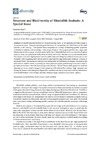Identificador persistente para citar o vincular este elemento:
https://accedacris.ulpgc.es/handle/10553/74321
| Campo DC | Valor | idioma |
|---|---|---|
| dc.contributor.author | Tuya, Fernando | en_US |
| dc.date.accessioned | 2020-09-09T12:09:27Z | - |
| dc.date.available | 2020-09-09T12:09:27Z | - |
| dc.date.issued | 2020 | en_US |
| dc.identifier.issn | 1424-2818 | en_US |
| dc.identifier.other | Scopus | - |
| dc.identifier.uri | https://accedacris.ulpgc.es/handle/10553/74321 | - |
| dc.description.abstract | Rhodolith seabeds function as 'ecosystems engineers', which globally provide a range of 'ecosystem services'. However, knowledge on the structure, composition and distribution of rhodolith seabeds is still lacking. This Special Issue comprises six articles, addressing specific questions of rhodolith seabeds, and covering a wide range of topics. Two papers provide new large-scale information on the presence, structure and distribution of rhodolith beds at two southern hemisphere areas, in particular continental shelfs off South Africa and Brazil. Another two studies contributed to the discovery on new algal species from rhodolith beds, including Sporolithon franciscanum, a new rhodolith-forming species from Brazil, and the small benthic alga Schizocladia ischiensis. In terms of associated fauna, the taxonomic composition and patterns of abundance of decapod crustaceans are described in another article, including the description of a depth-partitioning in the abundance of juveniles and adults of the crab Nanocassiope melanodactylus. Rhodoliths are often present in fossilized deposits, so we can track changes in their presence with climate fluctuations. High temperatures during the Eocene and widespread oligotrophic conditions are finally connected with low abundances of rhodolith beds at mid and high latitudes, despite a larger presence at equatorial regions. | en_US |
| dc.language | eng | en_US |
| dc.relation.ispartof | Diversity | en_US |
| dc.source | Diversity [EISSN 1424-2818], v. 12 (8), 300, (Agosto 2020) | en_US |
| dc.subject | 241705 Biología marina | en_US |
| dc.subject | 240106 Ecología animal | en_US |
| dc.subject.other | Biodiversity | en_US |
| dc.subject.other | Coastal Habitats | en_US |
| dc.subject.other | Coralline | en_US |
| dc.subject.other | Maerl | en_US |
| dc.title | Structure and biodiversity of rhodolith seabeds: A special issue | en_US |
| dc.type | info:eu-repo/semantics/annotation | en_US |
| dc.type | Annotation | en_US |
| dc.identifier.doi | 10.3390/D12080300 | - |
| dc.identifier.scopus | 85089939312 | - |
| dc.contributor.authorscopusid | 6603608107 | - |
| dc.identifier.eissn | 1424-2818 | - |
| dc.identifier.issue | 8 | - |
| dc.relation.volume | 12 | en_US |
| dc.investigacion | Ciencias | en_US |
| dc.type2 | Comentario | en_US |
| dc.description.notas | This article belongs to the Special Issue Structure and Biodiversity of Rhodolith Seabeds | en_US |
| dc.description.numberofpages | 2 | en_US |
| dc.utils.revision | Sí | en_US |
| dc.date.coverdate | Agosto 2020 | en_US |
| dc.identifier.ulpgc | Sí | es |
| dc.description.sjr | 0,697 | |
| dc.description.jcr | 2,465 | |
| dc.description.sjrq | Q1 | |
| dc.description.jcrq | Q2 | |
| dc.description.scie | SCIE | |
| item.grantfulltext | open | - |
| item.fulltext | Con texto completo | - |
| crisitem.author.dept | GIR ECOAQUA: Biodiversidad y Conservación | - |
| crisitem.author.dept | IU de Investigación en Acuicultura Sostenible y Ec | - |
| crisitem.author.dept | Departamento de Biología | - |
| crisitem.author.orcid | 0000-0001-8316-5887 | - |
| crisitem.author.parentorg | IU de Investigación en Acuicultura Sostenible y Ec | - |
| crisitem.author.fullName | Tuya Cortés, Fernando José | - |
| Colección: | Comentario | |
Visitas
145
actualizado el 05-may-2024
Descargas
119
actualizado el 05-may-2024
Google ScholarTM
Verifica
Altmetric
Comparte
Exporta metadatos
Los elementos en ULPGC accedaCRIS están protegidos por derechos de autor con todos los derechos reservados, a menos que se indique lo contrario.
